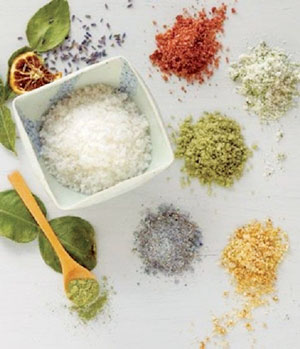Getting salty {recipe}
Q. What is all the rage with these different salts on the market? —Slippery from Slippery Rock
 A. First, a little background on salt. Known chemically as sodium chloride, salt is the most common of all ingredients and its use in cooking dates back to the Stone Age. Salt is an essential nutrient to the human body; although most people consume too much of it. It is instrumental in the preservation of certain food products. The basic sources of salt are either from salt mines in the earth or evaporated from ocean and sea water. Salt comes in many physical forms including rock, flake, crystalline and fine salt. During the production of salt, trace elements can be detected in different varieties of salt depending upon their source of origin and method of production. It is these trace elements that render each salt with a subtle, yet distinctive flavor profile and color. Among the more common specialty salts are “Fleur de Sel” (which translated means “flower of salt” in French), Himalayan Pink Salt and Hawaiian Sea Salt. Most people do not cook with specialty salts as it is generally considered cost prohibitive, however their distinctive flavor profile as a finishing salt is often sought by chefs and diners. Sprinkling a little over a finished dish is probably the best way to appreciate these uniquely flavored salts. Does this help clarify things for you, Slippery?
A. First, a little background on salt. Known chemically as sodium chloride, salt is the most common of all ingredients and its use in cooking dates back to the Stone Age. Salt is an essential nutrient to the human body; although most people consume too much of it. It is instrumental in the preservation of certain food products. The basic sources of salt are either from salt mines in the earth or evaporated from ocean and sea water. Salt comes in many physical forms including rock, flake, crystalline and fine salt. During the production of salt, trace elements can be detected in different varieties of salt depending upon their source of origin and method of production. It is these trace elements that render each salt with a subtle, yet distinctive flavor profile and color. Among the more common specialty salts are “Fleur de Sel” (which translated means “flower of salt” in French), Himalayan Pink Salt and Hawaiian Sea Salt. Most people do not cook with specialty salts as it is generally considered cost prohibitive, however their distinctive flavor profile as a finishing salt is often sought by chefs and diners. Sprinkling a little over a finished dish is probably the best way to appreciate these uniquely flavored salts. Does this help clarify things for you, Slippery?
Am I making you hungry yet, Pete?
Chef Jeff’s Salt Pork
1 cup Salt
2 tablespoons Tinted Curing Mix (otherwise known as curing salt or pink salt)
10 pounds Pork Belly, fresh, trimmed
Combine the salt and the TCM to form a cure rub.
Coat the pork bellies with the cure rub, making sure all areas are thoroughly and evenly coated. Allow the pork bellies to cure for about 14 days. Note: It is recommended to overhaul the pork bellies every other day to redistribute the cure rub.
On or after the 14th day, rinse and dry the pork bellies overnight.
Cut them into the appropriate portion size and store until needed.










Leave a Comment